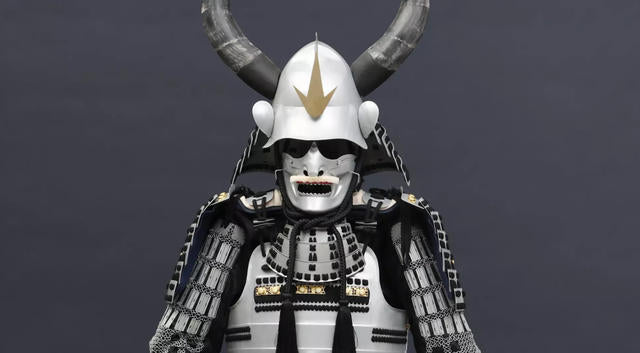Handmade Silver Japanese Samurai Armor with Helmet – History & Value
- Posted by COOLKATANA

What Makes a Handmade Full-Size Silver Japanese Samurai Armor a True Collectible Masterpiece?
For history enthusiasts and samurai culture collectors, a hand-forged full-size Japanese samurai armor is not just a stunning work of art—it is a vessel of history and spirit. This silver Japanese samurai armor with helmet faithfully recreates the honor and soul of the ancient warrior through exquisite craftsmanship, authentic design, and meticulous historical restoration. This article explores its historical background, craftsmanship, cultural symbolism, and collectible value from multiple dimensions.
What is a Samurai Armor Called?
Samurai armor, known as Yoroi in Japanese, originated during the Heian period (794–1185) and reached its peak during the Kamakura and Sengoku eras. Early armor was made from leather, iron plates, and silk cords, primarily designed for mounted archers. As warfare intensified and techniques advanced, the armor evolved—enhancing both protection and flexibility while becoming a symbol of status, loyalty, and honor among the samurai class.
Armor Styles in the Sengoku Period
During the Sengoku period (1467–1603), Japan was engulfed in civil wars, prompting major samurai clans to develop lighter, more agile armor such as Dōmaru and Ō-yoroi. Compared to earlier heavy designs, these new models emphasized mobility without compromising defense. Silver armor was often reserved for ceremonies or high-ranking generals, symbolizing nobility, power, and prestige.
Bushido: The Soul of the Samurai
Samurai armor was far more than battlefield protection—it embodied the Bushido spirit. Loyalty, courage, honor, and discipline were reflected in every detail—from the armor’s structure and engravings to its colors and family crests (Mon). A warrior clad in armor not only commanded respect on the battlefield but also represented the moral and spiritual strength of his clan.
Ceremonial and Cultural Significance
-
Spiritual Preparation:
Before donning armor, samurai performed meditation or prayer to calm their minds and focus their spirit. It was a ritual that balanced strength and serenity—a reminder to face death with discipline and resolve. -
Family Honor and Identity:
Family crests and distinctive colors on armor represented lineage and duty. For example, the Oda clan often used red and silver to symbolize courage and nobility, while the Tokugawa clan favored sober, balanced designs reflecting authority and stability. -
Symbol of Discipline and Unity:
Whether on the battlefield or during formal ceremonies, samurai armor served both functional and ceremonial roles—protecting the warrior while displaying composure, order, and the moral principles of Bushido.
For modern collectors, this handmade silver samurai armor with helmet is not merely a decorative display—it is a spiritual artifact that captures the essence of Japan’s warrior ethos. Every plate and rivet tells a story of the Sengoku era, conveying loyalty, discipline, and the eternal pursuit of honor.
Additionally, this armor highlights the pinnacle of Japanese traditional craftsmanship. Each piece is hand-forged, polished, riveted, and lacquered using time-honored techniques, combining functionality with beauty. Whether used for interior display, historical reenactment, or cultural collection, it stands as a magnificent representation of Japan’s samurai heritage.
Legendary Samurai Armor and Clan Heritage
The Sengoku era (1467–1603) was a turbulent age of warfare and shifting alliances. Samurai families not only fought for survival and power but also for legacy and honor. Their armor became a tangible expression of identity, hierarchy, and martial excellence.
Oda Nobunaga and the Legend of the Silver Armor
Oda Nobunaga, one of Japan’s “Three Great Unifiers,” was known for his innovative warfare and his army’s silver armor. The dazzling reflection of silver on the battlefield was said to intimidate enemies while showcasing Nobunaga’s dominance and prestige. The Oda clan’s use of silver symbolized both reverence for Bushido and the assertion of their elite status.
The Tokugawa Clan’s Authority and Discipline
The Tokugawa family favored simplicity, balance, and practicality in armor design. Tokugawa Ieyasu, the founder of the Tokugawa shogunate, used armor not only for protection but as a statement of moral authority. The family crest (Mon) on his armor signified lineage, responsibility, and the sacred duty to protect peace and order across the land.
Armor as Family Heritage
In many samurai families, armor was passed down through generations as a treasured heirloom. Each battle scar, restoration, and ceremony added layers of meaning, turning armor into a living record of a family’s history and values.
Heroic Tales Behind the Armor
Every samurai armor has a story: a young warrior defending his clan with agility and valor in a Dōmaru suit; a general commanding hundreds of men while his silver Kabuto gleamed under the sun. These stories give each piece emotional and historical depth, making modern collectors feel connected to Japan’s feudal heroes.
Modern Collecting and Cultural Significance
The handcrafted silver Japanese samurai armor stands today as a bridge between ancient warfare and modern cultural preservation. It combines artistry, history, and philosophy, allowing collectors to experience the “Soul of the Samurai.”
-
Historical Immersion and Ceremony:
Viewing or wearing this armor evokes the atmosphere of feudal Japan. The silver finish, gleaming softly under light, brings to life the dignity and courage of the ancient samurai. -
Cultural Legacy and Symbolism:
Every Yoroi armor pays tribute to Bushido—embodying loyalty, integrity, compassion, and respect. Through preservation and study, modern collectors continue to pass on the timeless values of the warrior’s code. -
Artistic and Educational Value:
Perfect for display in museums, martial arts dojos, or private collections, the armor serves as both an art piece and a teaching tool for understanding Japan’s feudal structure, craftsmanship, and aesthetics. -
Investment and Rarity:
Full-size handmade samurai armor is rare and highly valuable. Each set is crafted by skilled artisans using traditional forging and lacquering techniques. With the growing global admiration for Japanese culture, such pieces are gaining appreciation both artistically and economically.
Through this convergence of history, art, and spirituality, the handmade silver Japanese samurai armor (with helmet) transcends its function as a relic of war—it becomes a timeless cultural masterpiece. In owning it, collectors not only preserve a work of craftsmanship but also inherit the enduring honor, courage, and discipline of Japan’s legendary warriors.
Cultural Symbolism and Decorative Value
The silver samurai armor holds a special place in Japanese traditional culture — it represents not only power and honor, but also a deeper sense of aesthetic and spiritual beauty.
Symbol of Nobility and Purity
In Japanese culture, silver is often regarded as a “sacred color,” symbolizing purity, nobility, and fearlessness. During the Sengoku period, only high-ranking generals or noble samurai could wear silver armor, marking their elite status and indomitable spirit.
Craftsmanship and Cultural Heritage
Each piece of silver armor embodies the philosophy of Japanese craftsmanship. From the gentle metallic luster to the harmonious balance of silk colors, every detail reflects the essence of Wabi-Sabi — the beauty of simplicity, restraint, and depth. Every plate, rivet, and pattern is meticulously handcrafted, showcasing both practicality and artistic value.
Decorative and Display Value
Whether displayed in a traditional Japanese interior or a modern collection room, silver samurai armor becomes the focal point of visual impact. It fuses classical Eastern elegance with contemporary aesthetics, serving as both an artistic centerpiece and a symbol of honor and strength, enriching any space with historical depth and cultural prestige.
Spiritual and Symbolic Continuity
For many collectors, this armor is not just an artwork but also a spiritual emblem — representing perseverance, honor, and the unwavering courage to face challenges. It embodies the timeless “Soul of the Samurai,” allowing the Bushido spirit to shine even in modern times.
This handcrafted silver Japanese samurai armor with helmet blends history, art, and philosophy. It is not merely a collectible masterpiece, but a cultural treasure that speaks of Japan’s soul. For enthusiasts of samurai culture, historical reenactment, and fine craftsmanship, it stands as a perfect bridge between past and future.
Types and Design Features of Samurai Armor
Japanese samurai armor (Yoroi) evolved across different eras, each type tailored to unique combat and ceremonial purposes:
-
O-Yoroi (Great Armor)
Primarily used by mounted samurai during the Sengoku period, this heavy armor provided full-body protection through layered metal plates and leather cords. -
Dō-maru (Chest Armor)
A lighter, more flexible version designed for foot soldiers, balancing mobility and defense. -
Haramaki (Belly Wrap Armor)
Simple in design and easy to wear, often used by guards or lower-ranking samurai. Despite its lightweight structure, it maintains fine craftsmanship and decorative crests. -
Kabuto (Helmet)
The helmet protected the head while showcasing the warrior’s identity. Its crests, horns, and facial masks (Menpo) represented the samurai’s clan and battle prowess. The silver Kabuto, in particular, symbolized nobility and power — a hallmark of commanding officers.
Understanding these variations helps collectors appreciate the historical and cultural depth of this handcrafted silver Japanese samurai armor.
Handmade Life Size Yoroi,Silver Japanese Samurai Armor with Helmet
Handcrafted Artistry: Perfection in Every Detail
Each piece of this silver armor is meticulously handmade by master artisans:
-
High-Quality Materials – Crafted from durable metal alloys for strength, stability, and realistic weight balance.
-
Traditional Riveting Technique – Authentic riveting methods ensure both durability and aesthetic harmony.
-
Helmet Design (Kabuto) – The silver Kabuto exudes authority, featuring intricate detailing and clan insignias.
-
Wearable and Display-Ready – Suitable for both display and live use, such as reenactments, performances, or photoshoots.
Ideal for Collectors and Display Enthusiasts
With the growing global fascination for samurai culture, life-size handcrafted samurai armor has become a prized collectible.
-
Historical Reenactment – Perfect for samurai festivals, historical performances, and cosplay events.
-
Home Décor – Enhances the elegance of living rooms, libraries, or galleries with cultural gravitas.
-
Investment Value – Handcrafted, limited-edition production gives it strong long-term appreciation potential.
Modern Applications and Collectible Value
Today’s collectors acquire life-size samurai armor for both cultural preservation and personal enjoyment:
-
Historical Reenactments & Cosplay – Authentic reproduction enhances immersion in Japanese history and aesthetics.
-
Film & Photography Props – The intricate design offers high visual realism for cinematic and artistic productions.
-
Home or Museum Display – A striking exhibit that reflects sophistication and historical interest.
-
Investment Potential – With authentic craftsmanship and limited production, it is a valuable cultural asset with growing demand.
Conclusion
This hand-forged, full-size silver Japanese samurai armor with helmet is a tribute to Japan’s legendary warriors and their undying Bushido spirit. Whether for collection, display, or historical reenactment, it embodies the essence of honor, courage, and craftsmanship.
For historians, collectors, and samurai enthusiasts alike, this armor is an unmissable masterpiece — a living testament to the glory and discipline of Japan’s warrior heritage.
Add it to your collection today, and let the legend of the samurai live on before your eyes.










